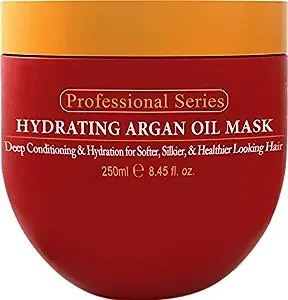Low Porosity Hair: Best Care Tips & Products
Low Porosity Hair: Best Care Tips & Products. It probably goes without saying, but haircare is not one-size-fits-all. If you have low porosity hair, products designed to hydrate your drier strands—like rich oils or heavy conditioners—may make your strands feel limp or weighed down. This may prompt you to use lighter-weight options, but those may not provide enough nourishment to fully moisturize your hair. If you don’t understand hair porosity, it can feel like a catch-22.

Fortunately, it’s not as confusing as it may sound. The key to mastering low porosity hair care is simply knowing what low porosity hair products to use and how. It’s also important to know what not to use on low porosity hair. We’ll explain it all and share our top low porosity hair tips ahead. Keep scrolling for your all-in-one guide to caring for low-porosity hair.
Arvazallia Hydrating Argan Oil Hair Mask and Deep Conditioner for Dry or Damaged Hair (8.45 oz Jar).
Deeply hydrates and moisturizes dry, damaged hair leaving it soft, silky, and easier to manage. Repairs and restores weak, overprocessed hair improving texture, elasticity and shin.

What Is Low Porosity Hair?
It may not look like it from afar, but your hair is structured similarly to a sponge—each strand of hair has tiny little pores that allow moisture to enter (and escape). Porosity refers to how well your hair is able to absorb and retain that moisture.
If you need a visual, it can be helpful to think of your hair cuticles as akin to shingles on a roof. When the cuticles (or “shingles”) are lifted, the hair is more porous, and your strands will more readily absorb moisture. When the cuticles are laid tightly together, however—as in the case with low porosity hair—it becomes difficult for moisture to get in or out.
Anyone can have low porosity hair, but it’s especially common for those with thicker, straight strands. Certain haircare habits can alter your hair’s porosity (bleaching your strands, for instance, may make your hair more porous), but on the whole, porosity is determined primarily by genetics.

SAUCE BEAUTY Hair Mask, Honey Chia Smoothing Curl Mask for Dry Hair (10.5 Fl Oz) Hydrating, Anti Frizz Softener with Shea Butter, Honey & Chia for Naturally Curly, Wavy & Coily Hair Care.
Honey Chia Smoothing Curl Hair Mask: At Sauce Beauty.
How To Treat Low Porosity Hair? Best Tips For Low Porosity Hair Care
Having a good hair day is your right, and that starts with appropriate hair nourishment. But lately, if, despite all the regular moisturising treatments, your strands still appear dry and damaged, then you might be missing out on an important concept- low porosity hair!
Now, there has been quite a buzz about this for some time, but there is still a lack of awareness regarding the same. So, brace yourself and get ready to learn everything about low porosity strands and how to care for them. Implementing effective tips will enhance your strands’ moisture absorption ability, leading to healthy, strong, and shiny hair.
Understanding What is Low Porosity Hair
Low porosity hair features tight hair cuticles that give your tresses a hard time absorbing moisture. Think of it this way- imagine your strands as a moisture-repelling umbrella. So, when water comes in contact with it, it simply slides off without getting absorbed through the surface. Having low porosity strands feels much identical!
The molecules of every strand cuticle are so tightly bound together that moisture finds it super difficult to get absorbed. Thus, now that you have gained a better understanding of low porosity hair meaning, it will get easier to learn about its symptoms and care tips.
Low Porosity Hair Alert: Signs to Identify Their Characteristics
Low Porosity Hair: Best Care Tips & Products. Just because hair appears dry and dull does not necessarily mean it has low porosity. Period! But still, if you wish to know whether your tresses need low porosity hair treatment, check for the following symptoms:
1. Simple Hair Wash Becomes a Lengthy Ritual
Are your tresses taking their own sweet time to become fully wet during a hair wash? It’s because their outermost surface is tightly bound. It is a classic indicator that you need a low porosity hair care regime.
2. Moisturising Products Refuse to Sink In
It is common knowledge that low porosity strands do not easily absorb moisture. Thus, when you use any hair moisturising products, they may still sit on the surface. For instance, when you apply hair oil, your tresses don’t absorb it easily, and your strands appear oily for a long time.
3. Dry Ends and Limp Curls Making Things Difficult
Appropriate moisture is the secret to happy tresses. But when they refuse to absorb moisture easily, they become dry and lose their natural curl definition, leading to dry hair and limp curls. It means there is a need for conditioning low porosity hair.
Simple Tests for Low Porosity Strands Revealed
If you want to know whether you have less porous tresses, you can do it with a few simple tests. Follow them as mentioned below:
1. Hair Float Test
Take a strand of hair, drop it in a bowl of cold water and note its immediate reaction. As the water becomes warm, all hair types will sink; hence, the immediate reaction of the strand is crucial here. If the strand keeps floating, you have low porosity strands.
2. Spray Bottle Test
Take a bottle with a spray nozzle and fill it with water. Spritz the water on your hair; if it rolls down into small beads over the surface of your tresses, it means it is not getting easily absorbed. It is an indicator that you have low porosity strands.
6 Characteristics of Low Porosity Hair
Low porosity hair has certain traits and characteristics that will affect the curl pattern and your hair texture. You can start to determine how your hair reacts to moisture by seeing how your curls, waves, or coils behave. Here are some key characteristics of low porosity hair:
- Leave-in products tend to sit on the hair rather than penetrate, so it’s very easy to apply too much which might result in scalp build-up.
- The hair is easily weighed down and can struggle to achieve volume, which may make you want to use volumizing hair products.
- When you spray some water on a clean, product-free strand, the water forms little beads on the surface rather than penetrating into the hair.
- It takes a long time for the hair to get fully wet.
- It takes a long time for the hair to fully dry.
- The hair doesn’t take color very well.
How Do You Test Your Hair’s Porosity?
If you can identify some of the above characteristics of how your tresses behave, you may have a good indication that you have low porosity hair. If you need more help determining if you have low porosity hair, you can test your hair using some simple methods.
Spray Test
- Start with clean, product-free hair
- Spray some water on a strand of hair
- Observe how your hair responds to the droplets of water
- If the water forms lots of little droplets on the hair surface without sinking in, you have low porosity hair.
Float Test
- Get a clean, product-free strand of hair (perhaps from a hairbrush)
- Fill a container with room-temperature water
- Place the strand on to the water
- If the strand floats it is likely to be low porosity.
Once you have determined you have low porosity hair, you can begin to find the best products for curly hair to look after it. If you need more help identifying your curl type, and what to use to care for it, you should take our curl quiz.
What Causes Low Porosity Hair?
If you have low porosity hair, you may be wondering what has caused it. Your hair’s porosity can be influenced by your genes, and can be hereditary. Curly hair in its untreated state is naturally higher in porosity than straight hair. Therefore, the curlier a strand is, the higher porosity it tends to be.
Using chemical treatments and frequent heat styling can also affect your hair’s porosity. This is because these can cause hair damage which leads to gaps and tears in your cuticles. That, in turn, will impact how porous they are.
Tips to Take Care of Your Low Porosity Care
1. Use Lightweight, Hydrating Products
Low porosity hair resists heavy oils and creams. So, use lightweight, water-based products. Look for ingredients like aloe vera, glycerin, and hydrolyzed proteins. These hydrate without adding weight. Pilgrim’s 3% Redensyl + 4% Anagain Hair Growth Serum is perfect for low-porosity hair. It hydrates without buildup. The serum’s Redensyl and Anagain complex boosts hair growth. It’s light enough for hair. Thus, it’s an ideal fit for your low porosity hair care routine.
2. Apply Products to Damp Hair
Low porosity hair resists moisture. So, apply products to damp hair to lock in hydration. After washing, gently blot hair with a microfiber towel or T-shirt. Leave it slightly damp. This helps products penetrate and nourish the hair better.
3. Embrace the LOC Method
The LOC method (Liquid, Oil, Cream) is great for low porosity hair. Here’s the process:
- L (Liquid): Start with a water-based leave-in or mist. This opens the hair cuticle for better product absorption.
- O (Oil): Next, apply a light oil, like argan or grapeseed. This locks in moisture without greasiness.
- C (Cream): Finally, use a light cream to seal in moisture. Avoid heavy creams to prevent buildup.
The LOC method layers moisture, keeping low porosity hair healthy and soft.
4. Limit Protein Treatments
Protein is key for strong hair. But low porosity hair doesn’t need extra protein. Its cuticles are tight, so too much protein makes hair stiff and brittle. For low porous hair treatment that involves multiple products, space them out. Also, pick products with tiny amounts of hydrolyzed proteins. These are easier to absorb.
5. Opt for Heat During Deep Conditioning
Applying heat during deep conditioning helps low porosity hair absorb treatments better. First, put on the deep conditioner and a plastic cap. Then, gently warm your hair with a hooded dryer or steamer for 15-20 minutes.
This added warmth helps the conditioner penetrate deeper, maximizing benefits. However, avoid overheating, as too much heat can harm hair.
6. Avoid Heavy Oils and Butters
Oils and butter, such as coconut oil and shea butter, benefit high porosity hair. However, they can leave low-porosity hair greasy or sticky. For low-porosity hair, opt for lighter oils like argan, grapeseed, or jojoba. These are less likely to weigh your hair down.
Pilgrim’s Patuá Anti-Grey Hair Serum is a lightweight option that nourishes low-porosity hair without buildup. Made with patuá oil, it adds shine and resilience without leaving residue.
7. Be Mindful of Product Buildup
Low-porosity hair often traps products, making it dull and heavy. To prevent this, use fewer styling products. Also, add a mild clarifying shampoo to your routine once a month. These shampoos clear away product buildup, pollutants, and hard water effects, keeping your hair fresh and allowing better moisture absorption.
8. Incorporate Steam for Extra Hydration
Steaming is a great way for low-porosity hair to absorb moisture. It opens up hair cuticles, allowing better absorption of moisture and nutrients from conditioners or treatments. You can use a handheld steamer or simply take a warm shower. Just let the conditioner sit in your hair while you shower.
9. Rinse with Warm Water
Cold water is often suggested to close cuticles. However, hair with low porosity benefits more from warm water. Warm water slightly opens cuticles, aiding moisture absorption. To lock in moisture, finish with a cool rinse. Yet, starting with warm water boosts the conditioner’s effectiveness.
10. Maintain a Consistent Routine
Consistency is crucial for all hair care, especially low-porosity hair. This type needs regular moisture. Follow a weekly plan: hydrating washes, light conditioning, and occasional clarifying. This keeps your hair healthy.





